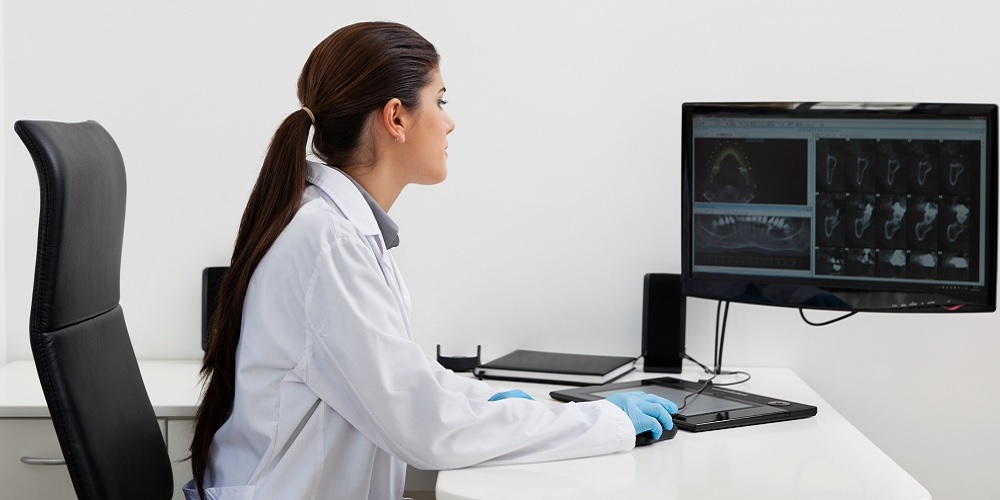Healthcare Management: Improving Radiology Workflow

In the realm of healthcare management, radiology workflow optimization is critical. Radiology departments are often the source of bottlenecks in hospitals and patient care funnels, and these pain points can cause a significant reduction in quality of care and patient satisfaction.
The state of radiology workflows
Radiology workflows can break down at multiple points. The large numbers of patients referred for radiology and the chronic understaffing of radiology departments, combined with outdated technology and lack of organization, can exacerbate these issues and impact patient care. There are multiple factors at play.
Patient intake and registration
Patients coming in for an appointment can spend significant time in the waiting room, impacting patient perception of value of care. Reducing wait times can involve implementing technology use in the waiting room to speed up processes formerly managed on paper and designing patient flows to get individuals out of common spaces and into private ones as swiftly as possible. Ensuring patient comfort and frequently checking in can minimize the annoyance associated with a wait time of any length and shorten the period of “lost time” in the patient’s perception.
Patient no-shows
Missed appointments can severely disrupt all areas of healthcare management; radiology workflows are among the most affected. When patients don’t show up for their appointments, revenues are lost because the slots can go unfilled. If a patient is late, time is wasted due to having to shuffle patients around and reset expectations. Having a robust patient appointment reminder protocol in place can help reduce no-shows and late-shows and keep workflows running smoothly throughout the day.
Slow image review
Imaging review can take a long time and be performed under less-than-optimal circumstances. Communication errors internally can make this worse. Lack of a quality workstation and inadequate image-reading environments can stall radiology workflows at the review stage. Poor or delayed communication between consulting physicians due to incompatible systems or equipment can make the problem worse. Investing in modern workstations can help mitigate this issue. Using products that automatically alert the referring physicians when the report is ready and getting them a copy of the report can save the radiologist from wasting time on phone calls and follow-up.
Siloed information
If access to imaging results for physicians and patients is difficult to obtain or results are delayed, workflows hit a blockade at the end of the process. This leads straight to a backlog of incomplete follow-up tasks, causing frustration, a breakdown of radiology/referring physician relationships, and reduced patient satisfaction. Systems designed to speed the flow of information can help relieve the anxiety and stress felt by those anxiously awaiting results, driving referrer and patient satisfaction.
Radiologist burnout
Continually increasing pressure on radiologists can lead to burnout, contributing to and exacerbating the current shortage of radiologists in the US. When the work environment is less than optimal, there is a lack of the right tools to do the job effectively, and workflows keep getting stalled at various points, radiologists can become disheartened, frustrated, and overworked. The average incidence of errors increases, leading to greater demand for re-imaging. This causes an even larger workload, and the cycle continues, worsening conditions and encouraging churn at all levels of the department or practice. Technology that enables radiologists to read quickly and easily, with AI assist, a good reports distribution module, and all the needed advanced tools, can help reduce burnout.
Why streamlining is important
Streamlining with the help of technology can facilitate a better healthcare management radiology workflow.
Better working conditions
Modern workstations can improve working conditions for radiologists, speed up and automate common processes, and keep staff members sharper and more focused on the most important work of image reading. This reduces the margin of human error and increases patient quality of care, improving patient satisfaction and helping to build strong relationships with referrers.
Better front-office workflows
Shortening queues and wait times by streamlining front-desk processes can also improve patient satisfaction and increase scores. Patient satisfaction scores are crucial for the revenue streams of radiology, directly affecting reimbursement from insurers that use incentive-based systems, such as Medicare.
How Novarad can help
Novarad provides a full range of radiology technology solutions, streamlining workflows throughout your department or practice to ensure higher quality of patient care and increased patient satisfaction.
- NovaPACS with Enterprise Imaging improves work environments for radiologists, reducing errors and enhancing patient care. The all-in-one workstation enables advanced image processing and manipulation. It also enhances interactions with referrers, specialists, and patients, using a storyboard format to clearly communicate results.
- CryptoChart, with the Object Vault Cloud System, provides easy, secure access to results, with a simple-to-use QR code for patients and physicians.
- Nova RIS can deliver alerts for contraindications, unscheduled procedures, insurance pre-authorization, and STAT studies. This streamlines patient care at point of service, reducing delays and rescheduling.
Embracing technology is essential to healthcare management, improving radiology workflow by optimizing how processes are performed and under what conditions. Improved communications and the automation of common tasks, from patient reminders to final file transmission, can transform a radiology practice or department and enhance patient care, leading to higher patient satisfaction scores and increased revenues.
Here at Novarad, we believe that the key to a successful imaging center is to work smarter, not harder, to deliver the type of care and outcomes that patients desire.
To see how we can help improve your workflows, feel free to reach out to our workflow specialists today!
%20(3).png?width=1555&height=462&name=Novarad%20EHS%20Logo%20Full%20Color%20(1)%20(3).png)
